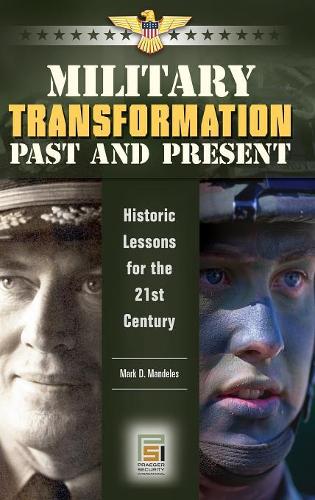
Military Transformation Past and Present: Historic Lessons for the 21st Century
(Hardback)
Publishing Details
Military Transformation Past and Present: Historic Lessons for the 21st Century
By (Author) Mark D. Mandeles
Bloomsbury Publishing PLC
Praeger Publishers Inc
30th September 2007
United States
Classifications
General
Non Fiction
Warfare and defence
355.00905
Physical Properties
Hardback
176
Width 156mm, Height 235mm
425g
Description
Transformation has become a buzz word in today's military, but what are its historical precursorsthose large scale changes that were once called Revolutions in Military Affairs (RMA) Who has gotten it right, and who has not The Department of Defense must learn from history. Most studies of innovation focus on the actions, choices, and problems faced by individuals in a particular organization. Few place these individuals and organizations within the complex context where they operate. Yet, it is this very context that is a powerful determinant of how actions are conceived, examined, and implemented, and of how errors are identified and corrected. The historical cases that Mandeles examines reveal how different military services organized to learn, accumulate, and retrieve knowledge; and how their particular organization affected everything from the equipment they acquired to the quality of doctrine and concepts used in combat. In cases where more than one community of experts was responsible for weighing in on decisionmaking, the service benefited from enhanced application of evidence, sound inference, and logic. These cases demonstrate that, for senior leadership, participating in such a system should be a strategic and deliberate choice. In each of the cases featured in this book, no such deliberate choice was made. The interwar U.S. Navy (USN) aviation community and the U.S. Marine Corps amphibious operation community were lucky that, in a time of rapid technological advance and strategic risk, their decisions in framing and solving technological and operational problems were made within a functioning multi-organizational system. The Army Air Corps and the Royal Marines were unfortunate, with corresponding results. It is characteristic of 20th-century military history that no senior civilian or military leader suggested a policy to handle overlapping responsibilities by multiple departments. Today's policymakers have not learned this lesson. In the present time, while a great deal of thought is devoted to proper organizational design and the numbers of persons required to perform necessary functions, there is still no overarching framework guiding these designs.
Reviews
Mandeles seeks to look at military transformations in the past in order to facilitate such transformations in the present and future. He sees military transformation as requiring a number of critical ingredients that taken together explain how military organizations learn..Recommended. Professionals and practitioners. * Choice *
Mandeles examines previous large-scale changes in military capability and draws inference to current and future questions of military transformation. Early chapters compare how the Navy's aviation planners and the Army Air Corps approached technological and operational uncertainty, and how the U.S. Marine Corps and the Royal Marines developed amphibious operations before WWII. The conclusion lays out a very reasonable argument for keeping the Department of Defense structure multi-organizational, arguing that interaction among groups of organizations enables innovation by enhancing the application of evidence, inference, and tactical knowledge. * SciTech Book News *
The historical sections, which make up most of the book, will appeal to an even broader audience. This book has the strongest possible recommendation for the serious military professional * RUSI *
Mandeles suggests two audiences for his book: senior military and civilian leaders within the national security establishment and the military analysts who serve them and the public. Both groups would be well served to consider this book and its implications for the future organization of the Department of Defense. * Joint Force Quarterly *
Author Bio
Mark D. Mandeles is the author of The Future of War: Organizations As Weapons,(2005), Managing Command and Control in the Persian Gulf War (Praeger, 1996), and The Development of the B-52 and Jet Propulsion: A Case Study in Organizational Innovation.
